Franco appears wearing bright pink sunglasses and Mussolini waves from a balcony while Adele’s Someone Like You plays in the background. On TikTok, a video showing bees being gassed on a streetlamp with the hashtag #extermination, uses Erika March, a song linked to Nazism for its use in military ceremonies of the Third Reich. On the platform, more than 24,500 videos use the same soundtrack. That is the first stage: the normalisation of fascism through pop culture. Memes, fascist speeches, military marches...
At the same time, disinformation circulates about housing, dams, the Spanish Social Security system and other false achievements attributed to Franco. On Telegram, dozens of channels deny the Holocaust or manipulate victim numbers, while users can download books with a single click that deny the existence of gas chambers in Nazi concentration camps. The goal is to normalise acceptance, driven by conspiracy theories and disinformation.
The celebration of Franco Fridays on X (formerly Twitter), Führer Days or Fascist Saturdays instituted by Mussolini in 1935, and the use of Blas Piñar and Primo de Rivera speeches in TikTok videos all contribute to the idolisation of these figures. And all of this content has already spread across social media with varying degrees of coordination and behavior depending on the platform. It's ‘pop fascism,’ and it seeps into our daily lives through multiple elements of contemporary culture.
‘Pop Fascism’: rewriting history in the digital age
This article is the first in an international investigation conducted by Maldita.es (Spain) and Facta (Italy). The project explores how, through the use of contemporary elements of social media, fascist discourse manages to enter our daily lives in three phases: normalisation, acceptance, and idolisation, employing multiple strategies, such as disinformation.
This research has been made possible thanks to the support of Journalismfund Europe.

From military marches to Cara al Sol and M come Mussolini: the soundtrack of ‘Pop Fascism’ on social media
The soundtrack of pop fascism on social media spans all genres and has managed to adapt to current trends and technological advances. There's even room for less current, but no less mainstream, musical trends. Particularly common are posts using songs directly linked to Francoism, among which disinformation creeps in. A prime example is the wave of manipulated videos circulating on social networks that appear to show famous artists performing a modern version of Cara al Sol, the anthem of the Spanish Falange composed in 1935 and adopted in 1937 as the “national song” of Franco’s regime. We have identified altered videos of performances by singer Aitana, Quevedo, and DJ David Guetta.
Even soccer players' images have been used, such as in a manipulated video of French-Spanish soccer player Le Normand playing Cara al Sol on the piano. Fake videos that become disinformation. “By using their images, songs, or public appearances linked to an emblematic anthem for Francoism and Falangism, such as Cara al Sol, they aim to introduce them to the youth circles that follow them and normalize the anthem as just another song in their repertoire,” explains Matilde Eiroa, senior academic at the Carlos III University of Madrid and author of the book Franco, from hero to comic figure of contemporary culture.
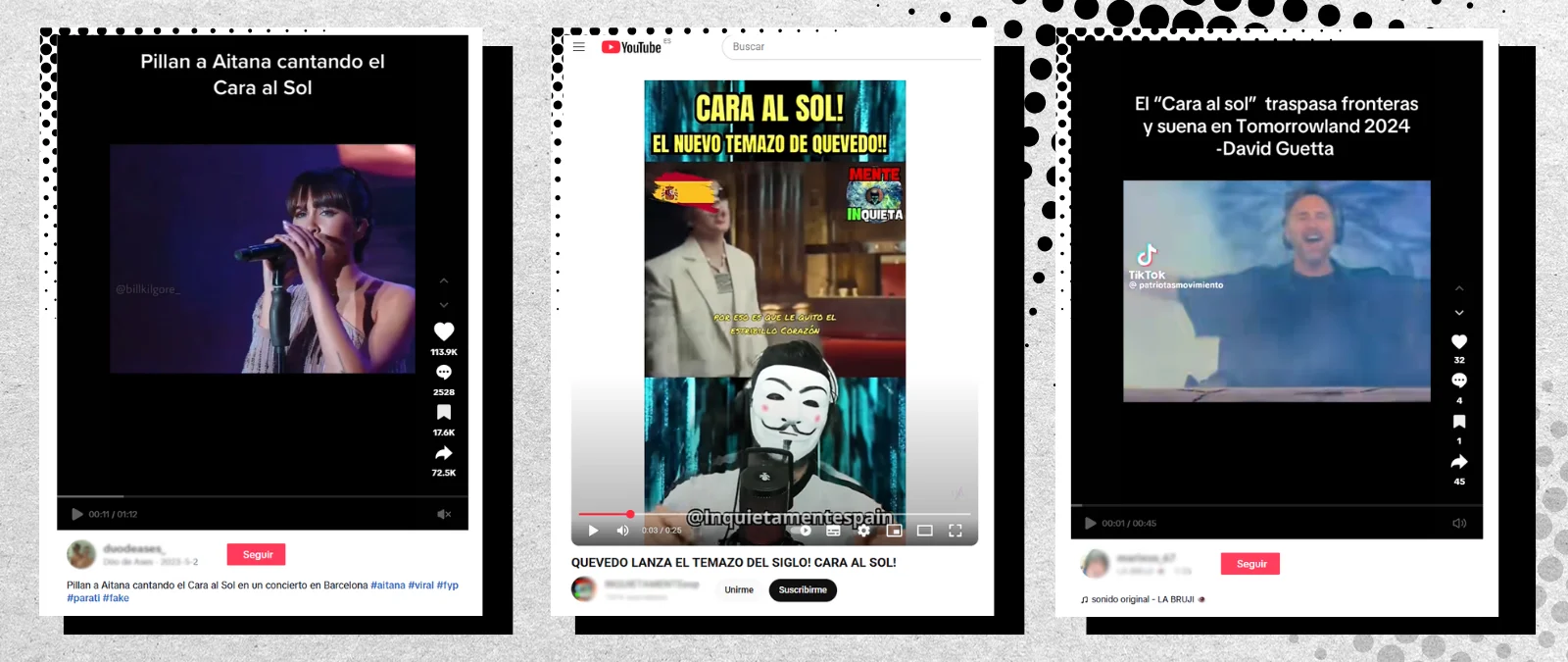
The normalisation of this music has also moved offline. On 5 October 2024, a mega-concert took place near Toledo (Castilla-La Mancha, Spain) with the participation of several international RAC (Rock Against Communism) music groups, a movement linked to neo-Nazi ideology that emerged in the United Kingdom in the late 1970s. In September 2024, the Italian group Veneto Fronte Skinheads held a Nazi rock concert in Verona to commemorate Ian Stuart Donaldson, founder of the English neo-Nazi network Blood and Honour. Even Italy’s most well-known far-right movement, CasaPound, has its own reference band: ZetaZeroAlfa, founded by CasaPound leader Gianluca Iannone in the late 1990s.
RAC music is present on major online streaming platforms (Spotify, Apple Music, Amazon Music, etc.) as well as on social media. Hundreds of Spanish-language content uses audio from a 2001 song called División Azul by Toletum, a group from that Spanish-language movement. A TikTok audio clip of that song has been used in more than 1,700 videos that remain available on the platform. On Spotify, Toletum has more than 27,000 monthly listeners. These songs often accompany images of Franco or Primo de Rivera, among others.
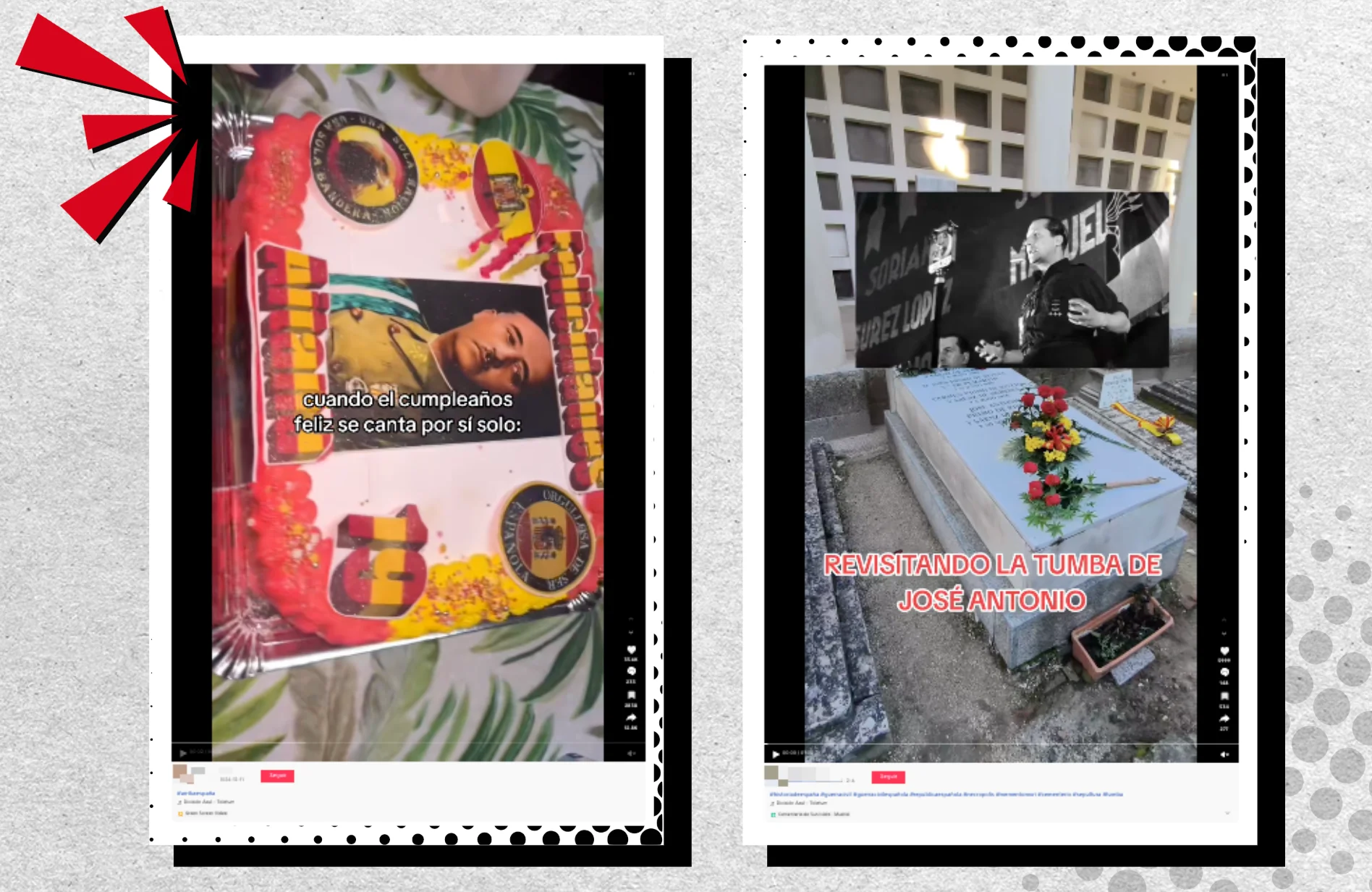
In Italy, popular songs like Adele’s Someone Like You or viral hits such as Mine by Bazzi are used to soundtrack images and videos of Mussolini, for example, while he delivers speeches in Rome's Piazza Venezia. The images appear with phrases like "I wish nothing but the best for you, too," propagating an altered, harmless, and even desirable image of Il Duce.
On TikTok and YouTube, users can find AI-generated videos of an animated Mussolini avatar dancing on stage, in school hallways, and on a basketball court, often set to catchy original songs praising the Duce. The lyrics of one of these songs, for example, go: “M like Mussolini / everyone likes me / mothers and children.”
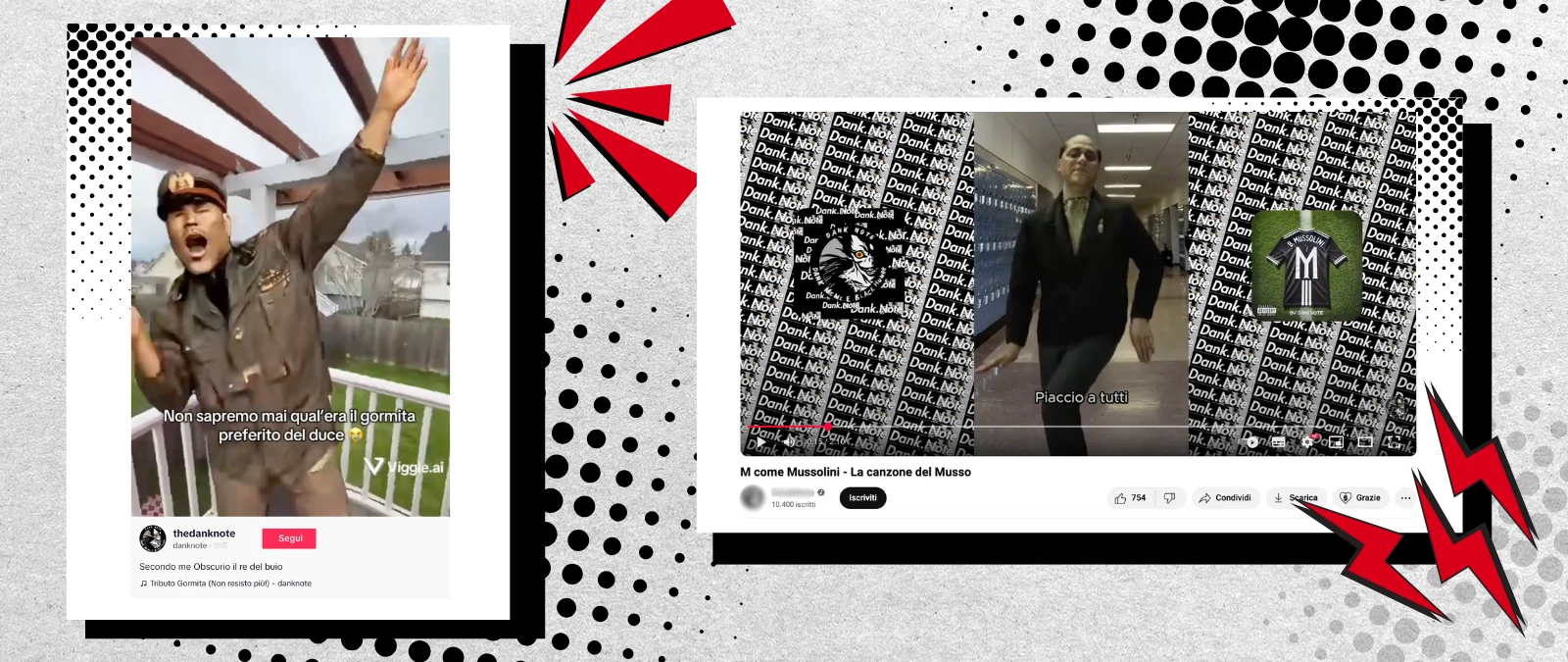
From Primo de Rivera’s speeches to ‘Franco Fridays’: how these figures are glorified through multiple strategies, including disinformation
They go beyond music. The content also uses fragments of speeches, with two main protagonists: José Antonio Primo de Rivera, founder of the Falange, and Blas Piñar, a politician and jurist who served as president of the far-right party Fuerza Nueva during Spain’s transition to democracy. Audio (and, less frequently, video) clips of their public interventions are used to exalt their image, idolise them, or defend their political ideals.
An example is a TikTok audio used in nearly 400 videos, featuring one of Francoism’s main slogans: “Spain, one, great, and free” (“Una, grande y libre”), the founding slogan of the Francoist imaginary that condensed the myth of eternal and indivisible Spain into three words that are easy to memorize and repeat, as indicated in an article from the University of Alicante.
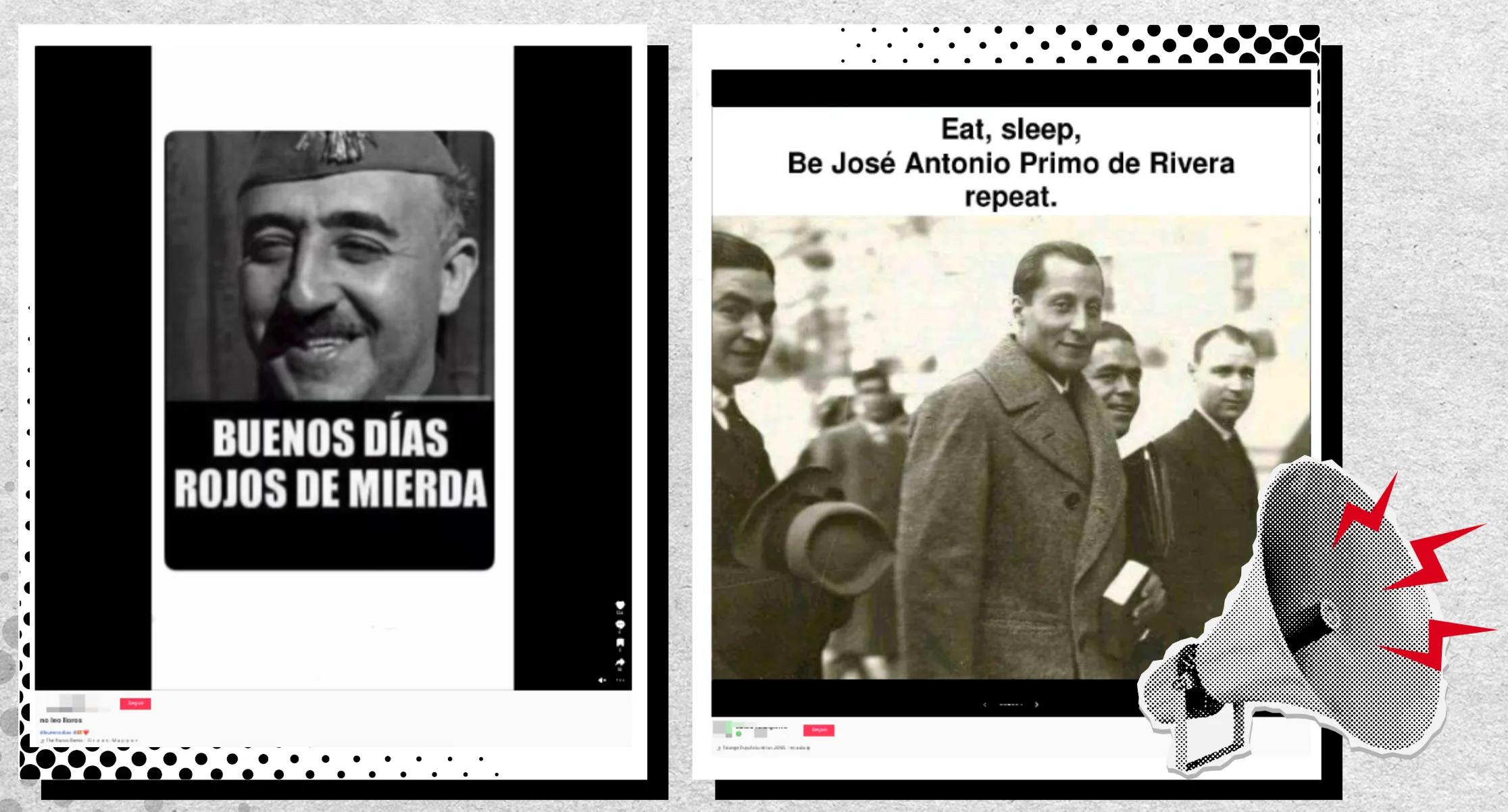
Generally, content using these resources features symbols related to the Francoism, such as the Cuelgamuros Valley (known until 2022 as the Valley of the Fallen), a symbol of memory of Francoism and the burial place where Primo de Rivera and Francisco Franco were buried until their exhumations in April 2023 and October 2019, respectively, following the implementation of the Historical Memory Law (Democratic Memory Law in 2022); or the Spanish flag, used during the Franco dictatorship, featuring the eagle of Saint John the Evangelist.
In 2024, the organisation Media Matters for America warned that AI-generated audios of Hitler’s speeches in English were circulating on TikTok, racking up millions of views. For Matilde Eiroa, this type of content focuses on “superficial aspects such as military aesthetics” or “logos with aggressive colors” (such as red and black, the Falange's signature colors and also used on the Nazi flag) that glorify “fascist or National Socialist aesthetics and become elements of a digital subculture.”
To this end, these actors also spread disinformation narratives and content that praise the supposed achievements of these dictators through various techniques. In Spain, for example, through content that compares Franco's regime with current events on issues such as housing or the construction of reservoirs, disinformation that has gone viral in recent months. Occasionally, through seemingly spontaneous interviews with people on the street, where participants end up saying things as “We lived better under Franco,” trying to legitimise the narrative.
Other ways to praise these dictators is by dedicating a day a week to them. Mussolini's regime established “Fascist Saturdays” in 1935, which formally ceased to exist in July 1943, when the Duce regime fell. However, some users have continued to revive this fascist tradition on social media, 90 years after its implementation.
This isn't the only day on which a dictator is praised on social media. On Fridays, social media users celebrate both Hitler and Franco. For the German dictator, the term Führer Friday is used, referring to the title Hitler adopted in 1934 after abolishing the presidency.
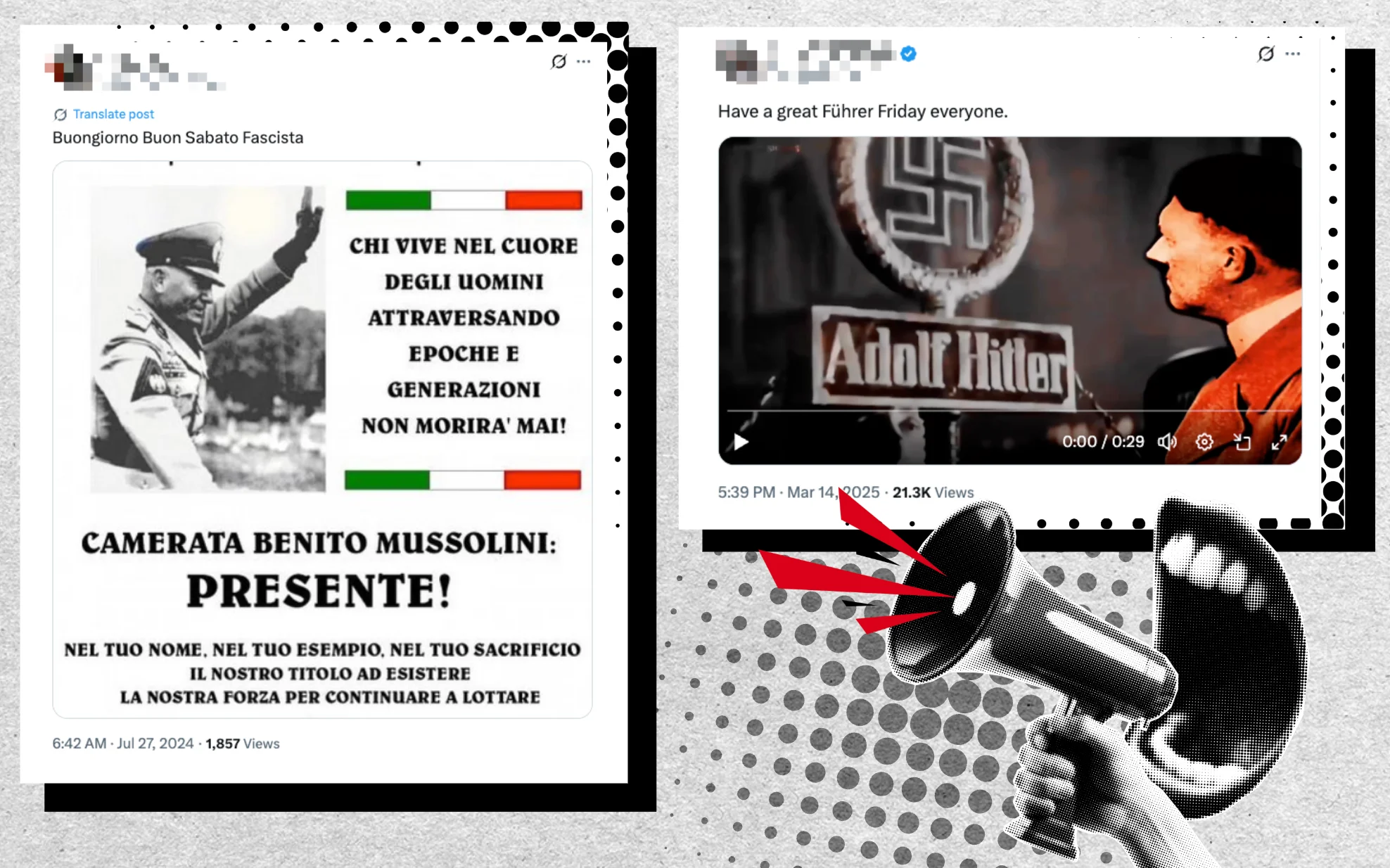
In parallel, there is also a space for Franco Fridays, whose origin on social media is unknown (the first posts we have located on X are from 2021). Jack Posobiec, who has previously spread conspiracy theories such as Pizzagate, also actively promotes Franco Fridays on X. His first mention of Franco Friday on his official X account dates to 29 December 2023. Since then, he has published dozens of posts referencing the term, each garnering thousands of views. He even shared an AI-generated song titled Uncle Frank, whose lyrics include: “A long time ago, Spain was in trouble, but then a man named Uncle Franco appeared. He was brave and bold” or “Uncle Franco beat the hell out of the reds.”
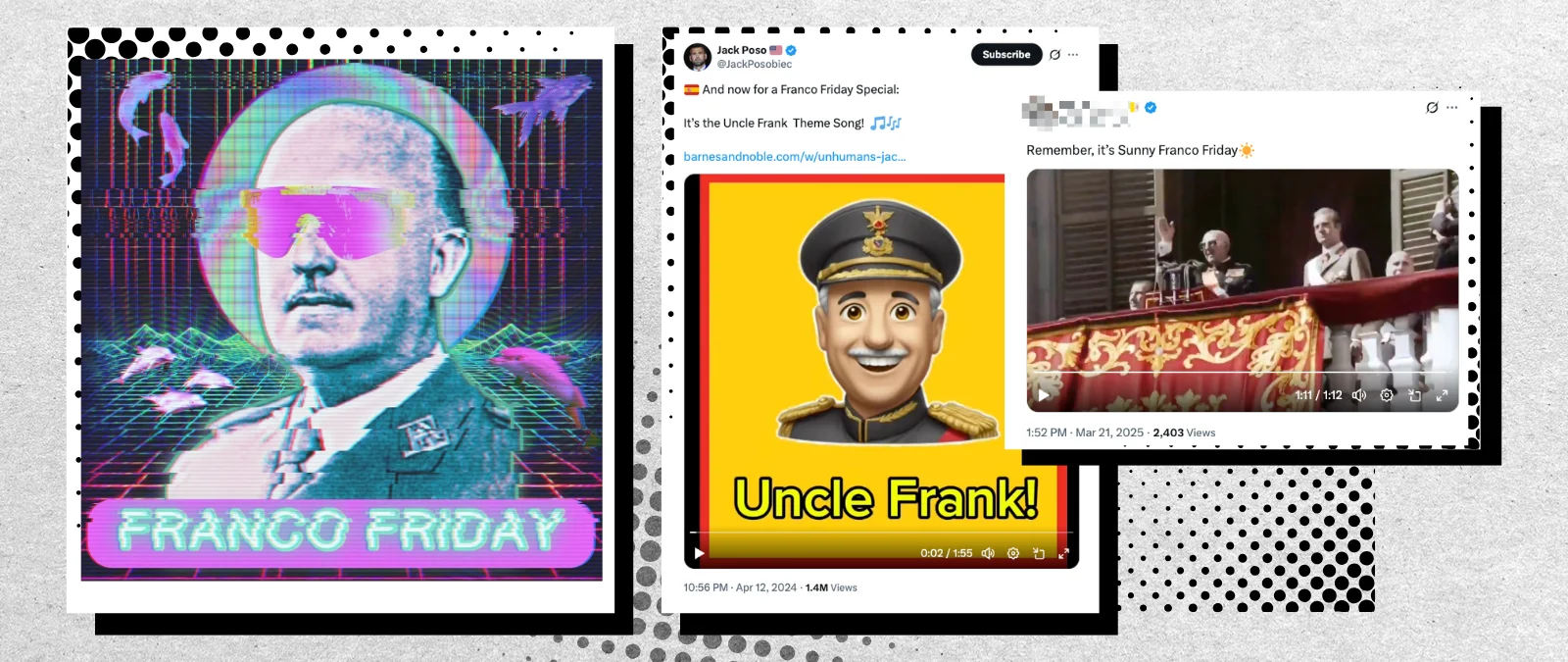
“Users who engage with these icons see these dictators as omnipotent figures who radically changed the societies they lived in, defying the norms of their time,” explains the professor Matilde Eiroa, in an interview with Maldita.es. In her words, these figures become “idols young people can cling to in order to show their rebellion against society.” This idealisation, she says, is not spontaneous: it is a combination of factors that has to do with the “spread of extremist ideologies, which benefits from digital platforms” and with the “social polarization” they perceive in their political, family, and educational environments.
There is also a current of sanctification, where these figures are deified or turned into martyrs. “There’s a lot of sanctification of these historical figures,” explains Kye Allen, Doctor of International Relations and researcher at the University of Oxford, who has published extensively on extremism and social media. This applies especially to those executed and later portrayed as “martyrs of neo-fascism,” such as Benito Mussolini, executed on 28 April 1945 alongside his lover Clara Petacci, their bodies displayed and desecrated in a Milan square; or José Antonio Primo de Rivera, executed on 20 November 1936 after being accused of conspiracy against the Second Republic and military rebellion.
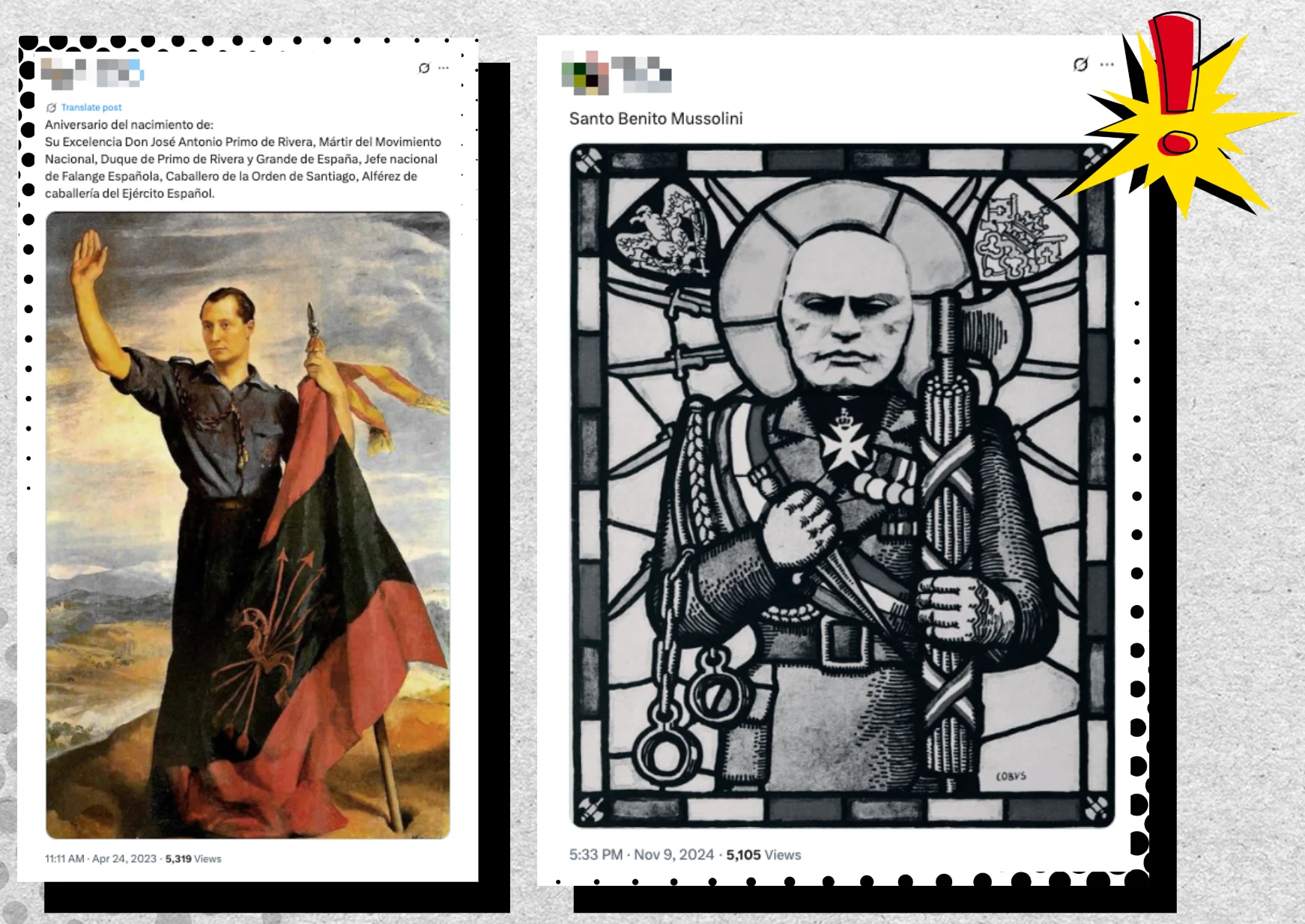
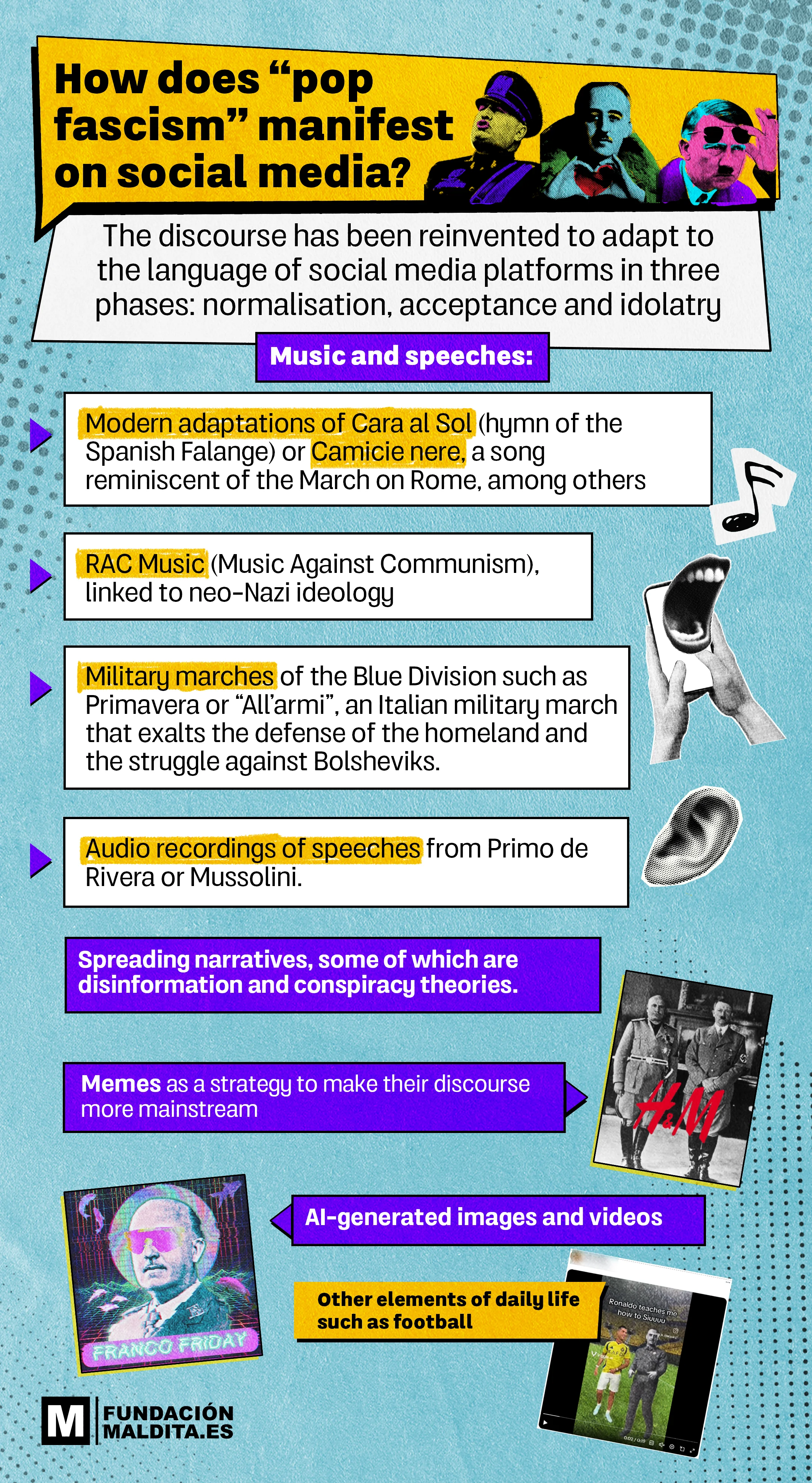
Franco in pink glasses, Hitler playing football or Mussolini dancing: how fascist propaganda has adapted its language to digital platforms
Franco reimagined as a green frog, Pepe the Frog, a harmless character from the comic strip Boy's Club created by Matt Furie, that later became a hate symbol; Mussolini and Franco dancing or Hitler mimicking Cristiano Ronaldo’s goal celebration. Images have a greater emotional impact than written text, and those who use them are aware of this.
Memes have become a crucial weapon in disinformation and manipulation campaigns, according to a study by the National Defense University Press, due to their ability to go viral easily, even among highly educated audiences (in fact, academic evidence has shown that the public is unlikely to immediately identify the origin and purpose of this far-right content).
Key Allen asserts that memes can reach young groups and “convince them of a revisionist historical narrative,” such as, for example, that during Benito Mussolini's dictatorship in Italy, rail services were punctual. “Neo-fascist groups have always adapted to the prevailing technologies of the time, so it's natural that they are now moving towards social media,” says Allen. They have thus reconfigured their strategies by adding new elements to their discourse. That is the case of memes: images or videos containing a block of text that can be easily shared on social media.
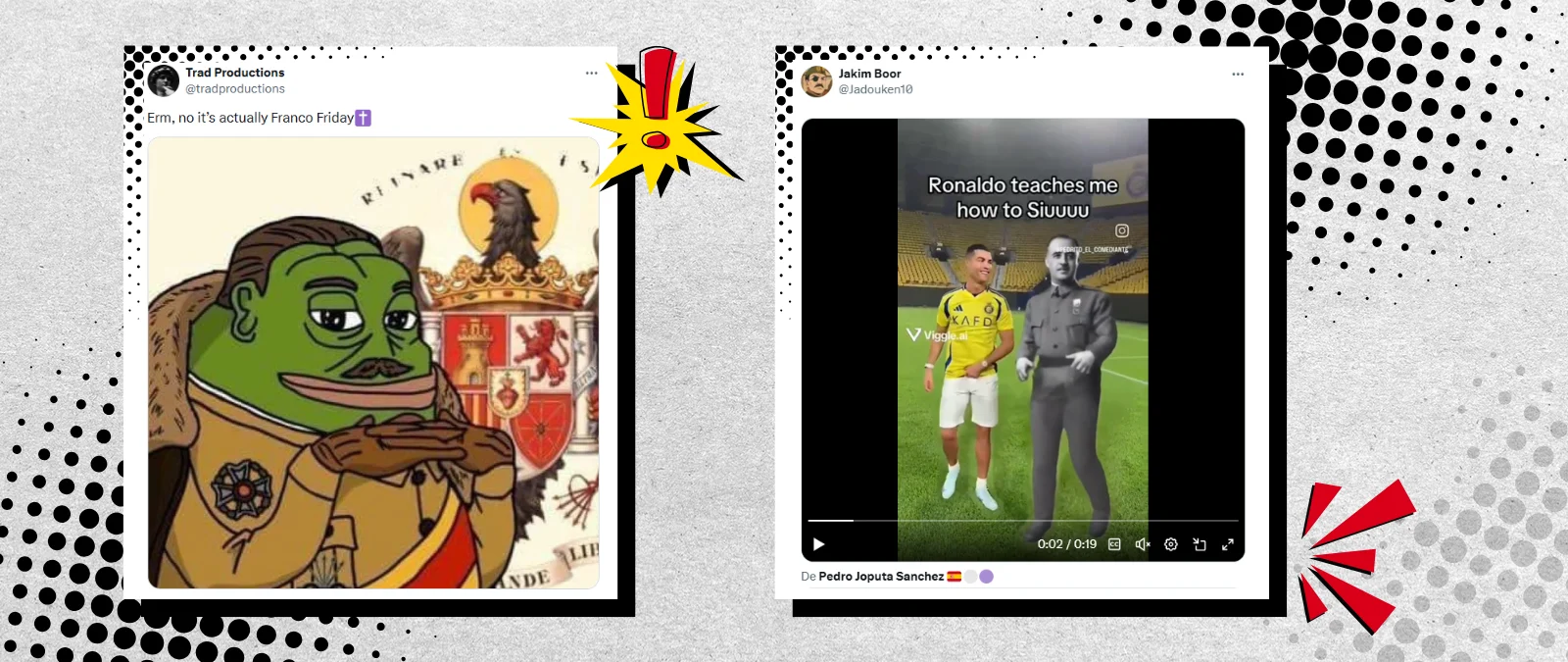
With this type of content, which makes communication more visual and less radical, the groups that promote it are trying to become more mainstream, more pop. In fact, a research article published in 2019 states that the spread of far-right ideology on the internet is closely linked to memes, which are capable of achieving wide dissemination and reach. In the long term, they can lead to an acclimatisation to extremist content, alongside the normalisation of radical statements.
Italian journalist and expert in politics and conspiracy theories Leonardo Bianchi explains to Facta that “irony is a crucial tool in today's far-right propaganda because it allows for plausible deniability: racist, anti-Semitic, or extremist things are said (or written), but at the same time the person denies having done so by hiding behind the screen of a joke.”
An example of how conspiracy theories and disinformation are spread through memes are those using the phrase “Save Europe,” often used in conjunction with interrelated references to the hashtag #aryanclassic. For Allen, these memes present the European continent “as a besieged entity, threatened by migration, liberalism, and so-called globalist elites.” This discourse, he says, “relies heavily on coded imagery and music, nostalgia for an idealised and pure Europe, and playful irony to mask extremist ideas,” for example against immigrants. On other occasions, memes are used to deny the Holocaust and its victims.
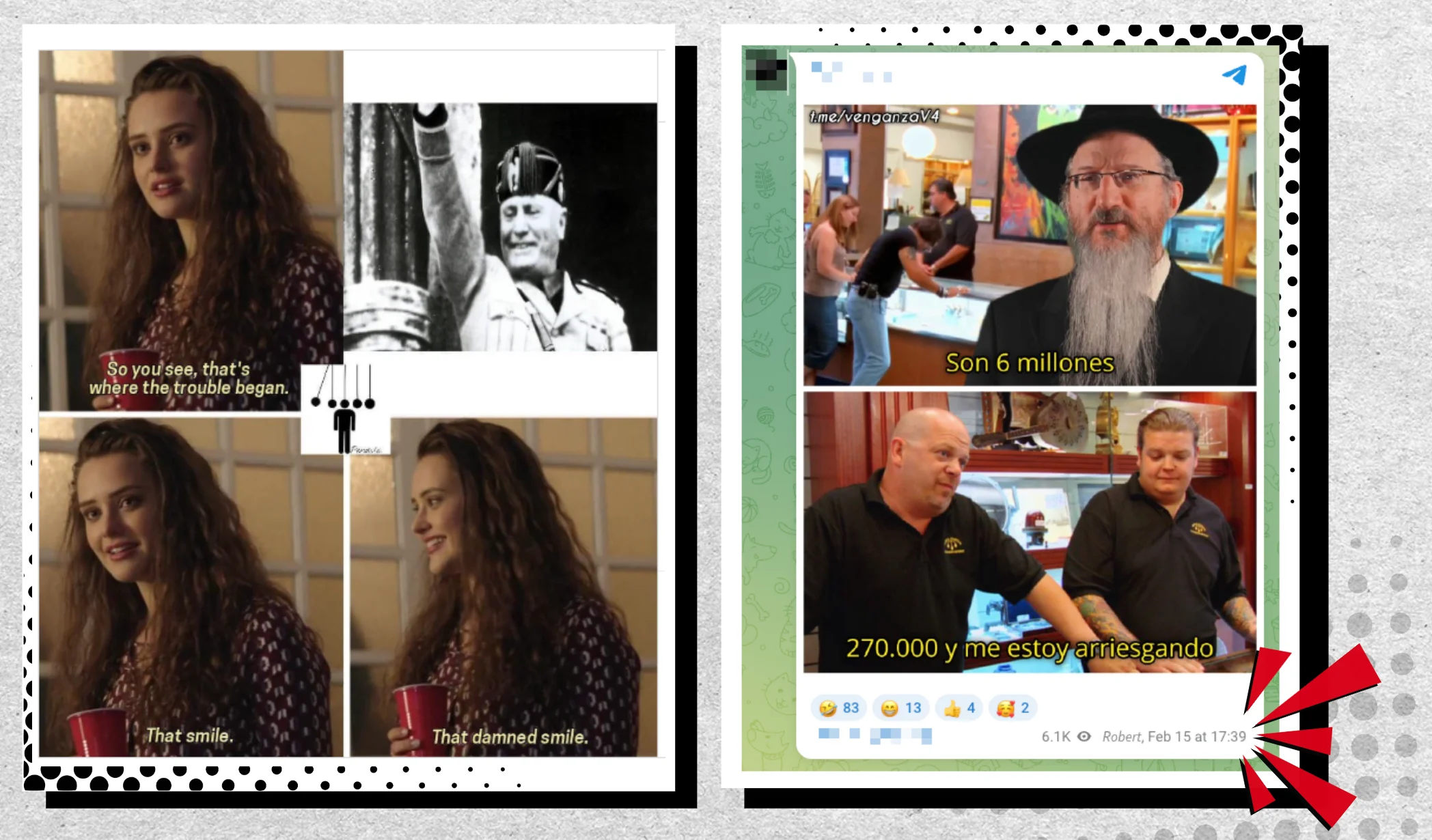
Football players and cartoons: ‘Pop Fascism’ in everyday life
Football is another sphere where dictators are glorified, often by exploiting current events, signings or viral moments. The names and faces of players are used as pretexts to talk about Franco, Hitler or Mussolini. The most notable recent example in Spain involves Franco Mastantuono, an 18-year-old Argentine footballer who signed with Real Madrid during the 2025 summer transfer window. Before the deal was officially confirmed, speculation about his future spread across social media, accompanied by dozens of posts ‘jokingly’ referencing Francisco Franco and the Francoist dictatorship, capitalising on the coincidence of names.
Some users fantasised about the crowd at the Santiago Bernabéu stadium (the home ground of the Madrid team) chanting Franco's name; others debated what his shirt would say or whether he would wear the number 39 (the year the Spanish Civil War ended); still others made puns about his position on the field, right winger.

This trend has also appeared with other players, such as Angelo Stiller, a German footballer who features in social media content for his supposed resemblance to Hitler. Another example is Romano Benito Floriani Mussolini, an Italian player and great-grandson of the dictator Benito Mussolini. He previously played for Lazio, a club whose ultras have displayed banners glorifying fascism. Although Floriani Mussolini has publicly stated that he wants to keep his second surname, at his current team, Cremonese, where he is on loan, his shirt simply reads Romano. In December 2024, a video circulated on social media showing Lazio fans celebrating a goal with the fascist salute.
Between late August and early September 2025, coinciding with the start of the Serie A season and Floriani’s debut, memes proliferated on X. They portrayed him as the ideal heir to the family tradition, accompanied by fascist slogans such as “Vincere e vinceremo” (“We shall win and conquer”), the war cry used by Mussolini when announcing Italy’s entry into the Second World War.

Was Donald Duck a fascist icon? It might sound absurd, but that’s a question some users may ask after seeing a viral clip of Donald Duck giving the Roman salute in front of an image of Hitler, or sleeping in a bedroom full of swastikas (a hooked cross adopted as the symbol of the Nazi party in 1920). They may look like edited deepfakes, but the images are actually real. They come from Der Führer’s Face (1942), a propaganda short film produced by Walt Disney Productions at the request of the U.S. Army during World War II. The aim of the film, which won an Oscar for Best Animated Short in 1943, was to “ridicule and condemn the evils of Nazism,” according to the Walt Disney Family Museum website. Yet on social media, the clip has been stripped of its original intent and given an opposite meaning: it is now used to glorify Hitler and fascist ideology. For example, one X post (now deleted) featuring the cartoon accumulated nearly five million views, with the caption: “These are the cartoons I’ll show my kids.”
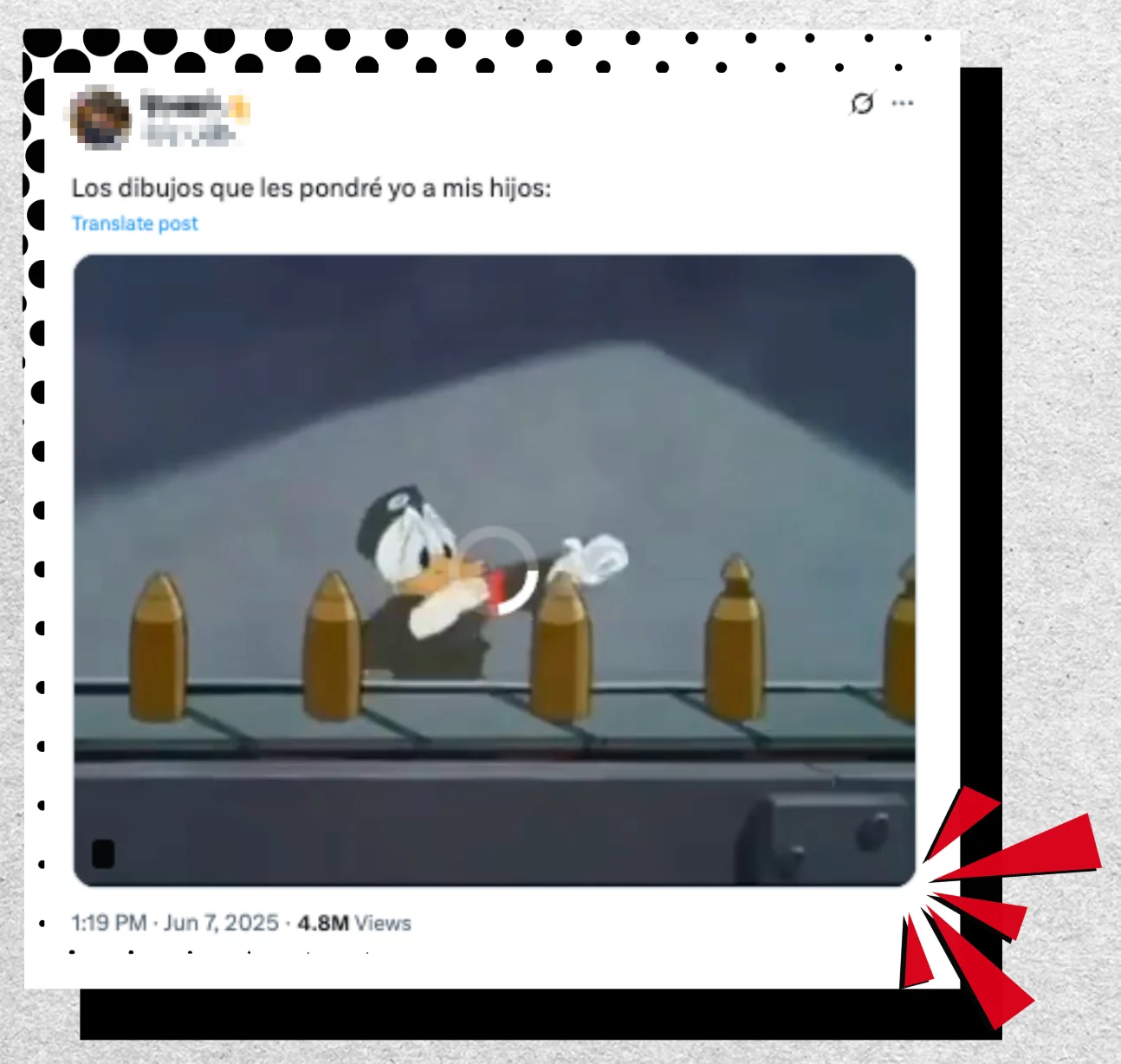
Other classic cartoons originally made as anti-fascist propaganda are also being repurposed online as pro-fascist content. One example is The Ducktators (1942), a Warner Bros production released as part of a series of propaganda shorts broadcast during the World War II, featuring a duck with a moustache (which is actually a caricature of Adolf Hitler), another bald duck with an Italian accent (representing Benito Mussolini) and a duck with glasses and a squeaky voice (a parody of Hideki Tōjō, a Japanese military officer who served as prime minister during World War II). The three form a dictatorship on the farm, where they simulate military marches, give fascist salutes and deliver speeches. Images of these moments circulate on platforms such as X, Facebook, and TikTok.
Cross-Platform, and sometimes coordinated, networks: how and where this content spreads
These contents circulate across multiple platforms, adapting to the specific logic and user behaviour of each one. On TikTok, for example, there is an abundance of videos featuring background music such as Cara al Sol or speeches by Primo de Rivera, among others, often paired with still photos or montages. On X (formerly Twitter), however, more content is published in the form of memes or references to Franco Friday. This also has to do with the users who disseminate it.
On Telegram and X, mainly, Maldita.es has identified more than 70 groups and channels aimed at a Spanish-speaking audience, which regularly share this content. For expert Kye Allen, “when we look at this type of discourse on TikTok, Instagram and the like,” coordination, in his experience, “is much more fragmented.” Often, he says, “these are individuals with their own accounts who move content” of this type, without needing to coordinate with others. However, he adds, “there is a certain degree of coordination: ideas are always learned and adopted among certain individuals and groups.” For the expert, this manifests itself in various ways: on an aesthetic level, by copying similar styles or through certain genres of content. “A popular genre today is the so-called ‘savior genre’,” a genre that includes “Save Europe” memes and conspiracy theories about the Great Replacement or the Kalergi Plan.
In Italy, Facta identified a particularly striking case in 2021: a network known as the Mattonisti (“bricklayers”) on X, a group of several hundred Italian accounts coordinated with each other. Behind these accounts, Facta explains, lies an organised Telegram channel where users coordinate which hashtags to push into trending topics, using current events to amplify reactionary content and normalise fascist and Nazi symbols. Their hallmark is the use of Wojak, a crudely drawn meme character used as a mask to represent negative emotions such as sadness and melancholy. In the Mattonisti ecosystem, Wojak becomes Mussolini or Hitler, transforming historical figures into pop icons with powerful visual appeal.
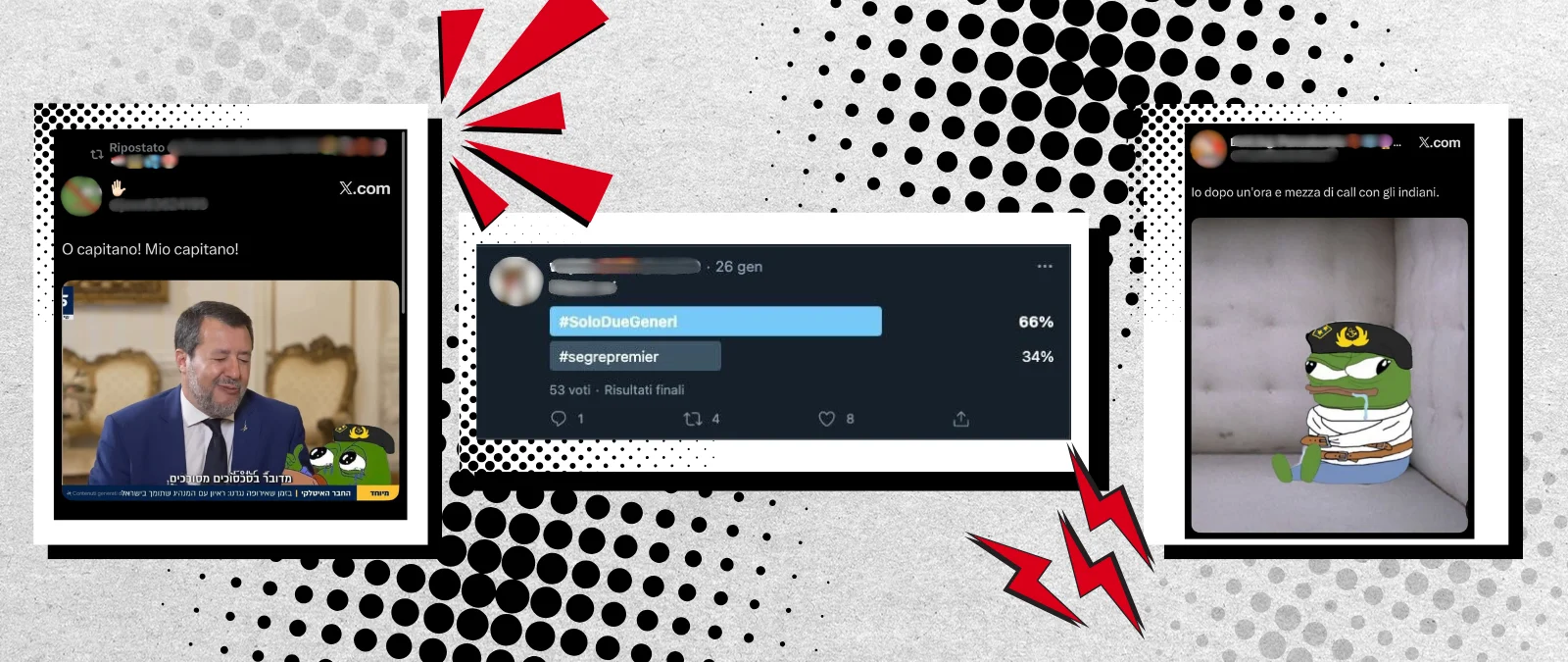
A 2024 report by the Institute for Strategic Dialogue (ISD) identified a TikTok network of more than 200 accounts that “openly supported Nazism and used the platform to promote their ideology and propaganda.” Even when there’s not always direct coordination, Allen insists that “there will be informal networks where we will see different accounts promoting similar content. They will follow each other, ‘like’ each other and share each other's content.” One example, he says, is the profile of the Spanish far-right activist Isabel Peralta, sentenced to one year in prison by the Madrid Provincial Court for a hate crime, a ruling she says she is appealing. She features prominently on the TikTok account of Heritage & Destiny, a British “neo-fascist magazine for which she serves as ‘foreign correspondent’, so she appears frequently on their TikTok account”, Allen notes. Back in 2023, Jeremy Corbyn, a Member of Parliament for the Labour Party, expressed concern about a visit by Peralta to the UK for an event organised by the magazine.
Peralta has almost 16,000 followers on TikTok and nearly 7,000 on her Telegram group.On the latter, she shares material from Núcleo Nacional, and other channels such as La Semilla de la Verdad, La Escoba de Dios, and La Biblioteca NacionalSocialista (a small channel with about 600 followers, though Maldita.es identified at least seven Telegram channels using the same name). She also amplifies international actors such as RadioGenoa (an Italian channel spreading xenophobic and anti-migrant content, also active in Spain), the Nordic Resistance Movement, and Die Dritte Weg (The Third Way), “a small far-right party based in southern Germany with a strongly neo-Nazi profile,” according to Germany’s Federal Agency for Civic Education, a German public body that promotes awareness of democracy and political participation.
Peralta’s connection to the German party goes back several years. In 2021, according to the German newspaper Der Spiegel, the Spaniard “received training in propaganda techniques” from members of this party. In 2022, German authorities denied her entry into the country after finding material with Nazi symbols in her luggage.
The content shared in those Telegram channels ranges from audiobook and PDF versions versions of chapters from Mein Kampf to Holocaust denial posts (which they refer to as “the holotale”, or “holoverse”, “holo-wash”, ‘holo-deception’) and which downplay or outright reject the six million Jewish victims documented by institutions such as the U.S. Holocaust Memorial Museum. These books, freely downloadable, question not only the death toll but the existence of gas chambers themselves, despite extensive historical and forensic evidence. One such text reads: “The story of the crematorium furnace presented as a gas chamber is very interesting, since no gas chambers have ever been found in those camps, it was a trick used very often.”
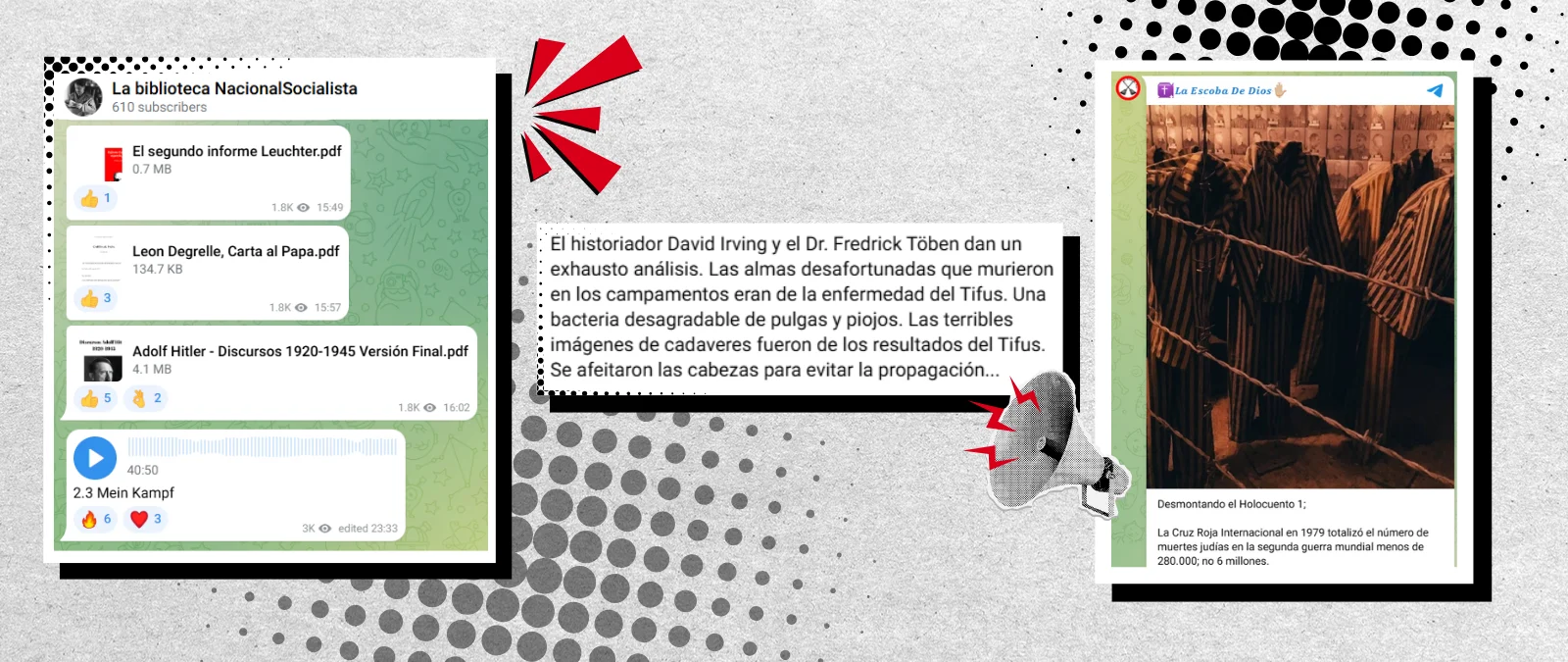
Methodology
This text is part of a cross-border research project conducted by Maldita.es(Spain) and Facta(Italy) between June and September 2025. During this period, the focus was on collecting content from six platforms (Facebook, Instagram, Telegram, TikTok, X and YouTube), as well as from websites. In total, more than 500 pieces of content were recorded, from which we gathered various types of information such as: user, date of publication, format, language, and impact, among others. Only posts glorifying Francisco Franco, Benito Mussolini or Adolf Hitler, or the measures and policies implemented during their respective dictatorships, or associated symbolism were selected. These contents were analysed individually. From this analysis, the most frequently repeated terms and emojis were extracted, in order to then study their possible hidden meaning within this movement. Various academic studies and expert publications were consulted to better understand their meaning.
If you have any questions, please contact us at [email protected].

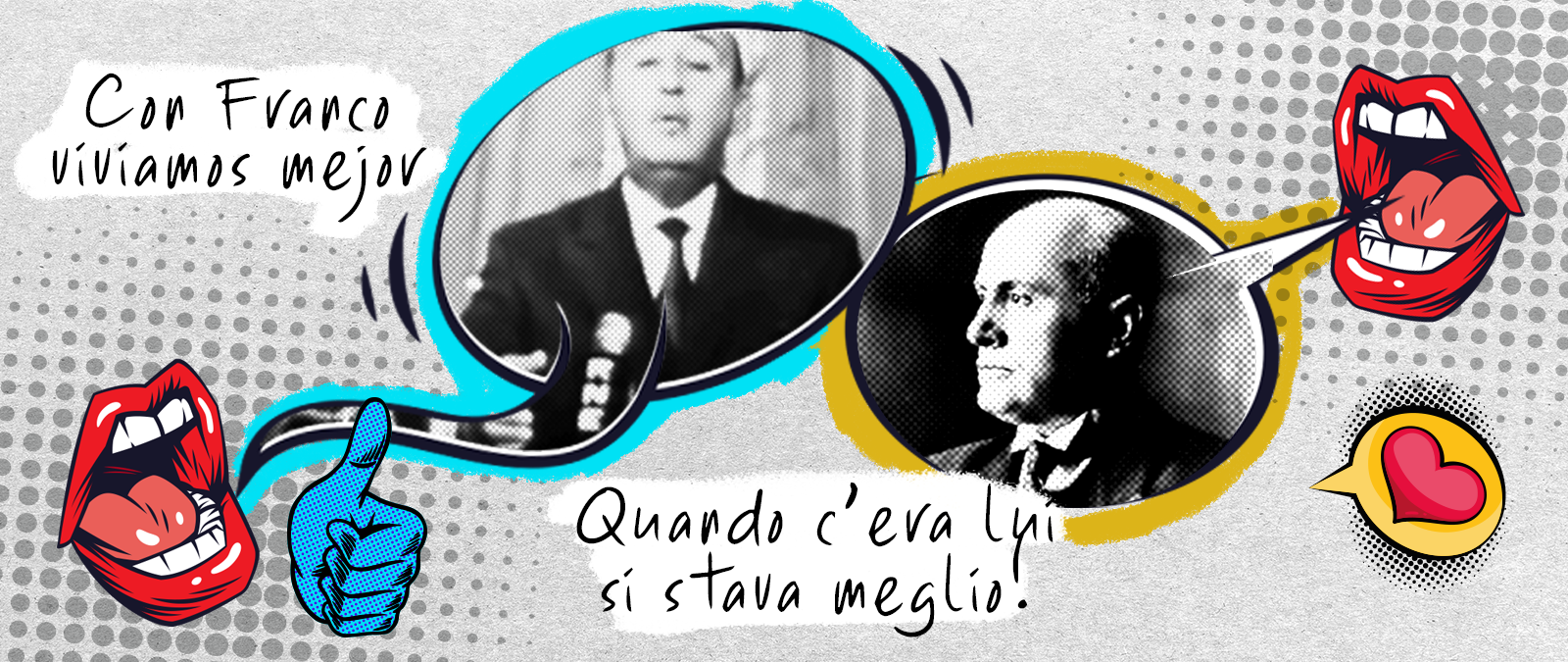 “We lived better under Franco”: the narrative that triumphs on social media and seeks to rewrite history through disinformation and other manipulation strategies
“We lived better under Franco”: the narrative that triumphs on social media and seeks to rewrite history through disinformation and other manipulation strategies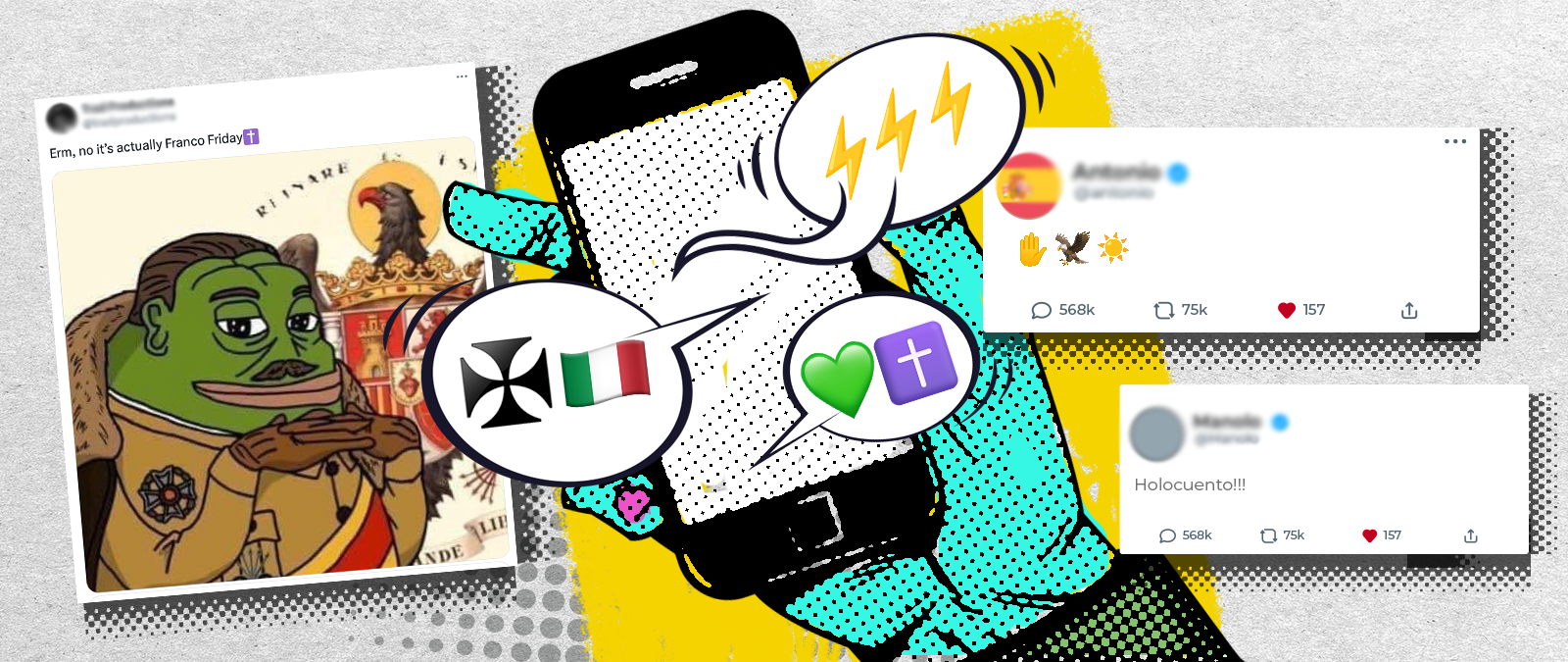 Coded language and memes: how 'Pop Fascism' smuggles disinformation and denialism into social media
Coded language and memes: how 'Pop Fascism' smuggles disinformation and denialism into social media